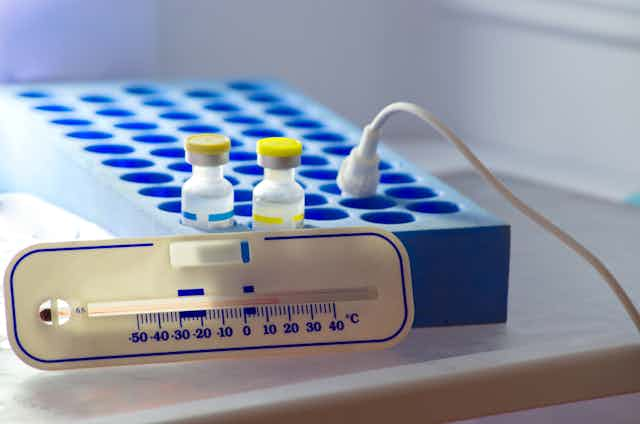Over the years vaccines have prevented countless cases of disease and saved millions of lives. Infectious diseases like polio, measles, diphtheria, pertussis (whooping cough), rubella (German measles), smallpox, mumps, tetanus and rotavirus used to be common around the world. Today vaccines can prevent them.
Despite this, one in five children in the world aren’t fully protected by even the most basic vaccines. In addition, almost 20 million are at risk of contracting preventable diseases because they are under-vaccinated. As a result about 1.5 million children die every year from diseases that can be prevented by vaccination coverage.
One of the main reasons is that there are many rural areas in the world that don’t have reliable power supplies. Vaccines need to be kept at particular temperatures, usually refrigerated, to remain effective. Cold chain conditions aren’t possible without power. A cold chain is a temperature-controlled supply chain that runs from the time the vaccine is produced until it’s administered. It holds the vaccines in a temperature of between 2°C and 8°C. A power outage can break this cold chain and result in the vaccine losing its effectiveness.
The Global Alliance for Vaccines and Immunization estimates that only 10% of health care facilities in the world’s poorest countries have a reliable electricity supply. In Uganda, for example, over 70% of health care facilities have inadequate access to mains power.
The World Health Organisation estimates that more than 50% of vaccines may be wasted globally every year because of temperature control, logistics and shipment-related issues.
Most government guidelines recommend that vaccines that have potentially been compromised should be discarded. This can be costly. In 2011, according to UNICEF, an estimated USD$ 1.5 million worth of vaccines were lost in five months, often due to difficulties maintaining cold chain vaccine supply to their remote location.
The WHO has developed a set of guidelines for governments in a bid to minimise exposure to high temperatures if a power outage happens. But our research shows that these guidelines don’t have any specific instructions on how health care facilities and pharmacies should implement backup systems. They also don’t provide a list of standardised equipment to prevent and deal with power outages. This would be helpful in both developed and developing country scenarios. Our research attempts to plug this gap.
Possible solutions
Transporting vaccines during campaigns that involve thousands of people in remote areas creates an immense logistical burden. But a number of things can be done to prevent vaccines from losing their potency and having to be replaced, at great cost.
Steps that can be taken include:
Better guidelines: The development of more comprehensive guidelines for health professionals. These should be based on systematically testing the stability and potency of vaccines and other medicines under a variety of conditions.
New equipment: Providing alternative equipment that can maintain temperature in a power outage. These include solar powered refrigeration cabinets, back up refrigerators, and data loggers. This will ensure temperature-sensitive medicines and vaccines can be preserved.
There are some promising developments. A vaccine storage device, Arktek has been developed for use in remote areas where power supply is unreliable. It is a super insulated device that maintains the integrity of vaccines by keeping them in ice in its inner chamber. It can keep vaccines at a temperature between 0°C and 8°C for 30 to 60 days, depending on outside temperatures and humidity. No powered refrigeration or additional ice is needed. The Arktek was successfully trialled to help with vaccinations during the 2014 Ebola outbreak and after the 2015 Nepal earthquake .
New vaccines: Developing vaccines that don’t require constant refrigeration from manufacture to distribution. These already exist, including thermostable vaccines which can be stored for extended periods above 8°C. Replacing the standard vaccines with heat-stable versions would lower costs and enable them to be used in challenging conditions.
Some existing vaccines, such as hepatitis A&B, inactivated poliomyelitis, diphtheria, tetanus, and HPV and rotavirus vaccines, do have good heat-stability profiles. Efforts are underway to allow them to be used outside the regular cold chain.
Other vaccines, such as for the Ebola virus, are currently the focus of research to improve their thermostability. This would significantly improve delivery during outbreaks, particularly in tropical regions where people live in remote communities without power.
There are also a number of groups investigating ways to produce other thermostable vaccines, such as an influenza vaccine. And reports suggest that using a meningococcal A vaccine that can be stored at higher than usual temperatures for a limited time has the potential to save 50% of vaccine costs compared to vaccines needing cold chain supply and storage.
Replacing the current oral rotavirus vaccine with a heat-stable formula could also save up to USD$10,945 per 100 people in Niger and could increase the overall vaccine coverage from 46% to 58%.
The benefits of thermostable vaccines are indisputable. But there are enormous technical and regulatory challenges. For example, the time and resources needed to prove that a vaccine is still effective after exposure to high temperatures is considerable, and manufacturers need to be satisfied that investing the necessary funds to generate this data is valuable.
The development of thermostable vaccines – and the relabelling of some existing vaccines as able to be stored outside the cold chain for a limited time – will contribute significantly to the delivery of additional vaccines. It will also make substantial savings in wasted vaccines and logistics, including cold chain equipment.


